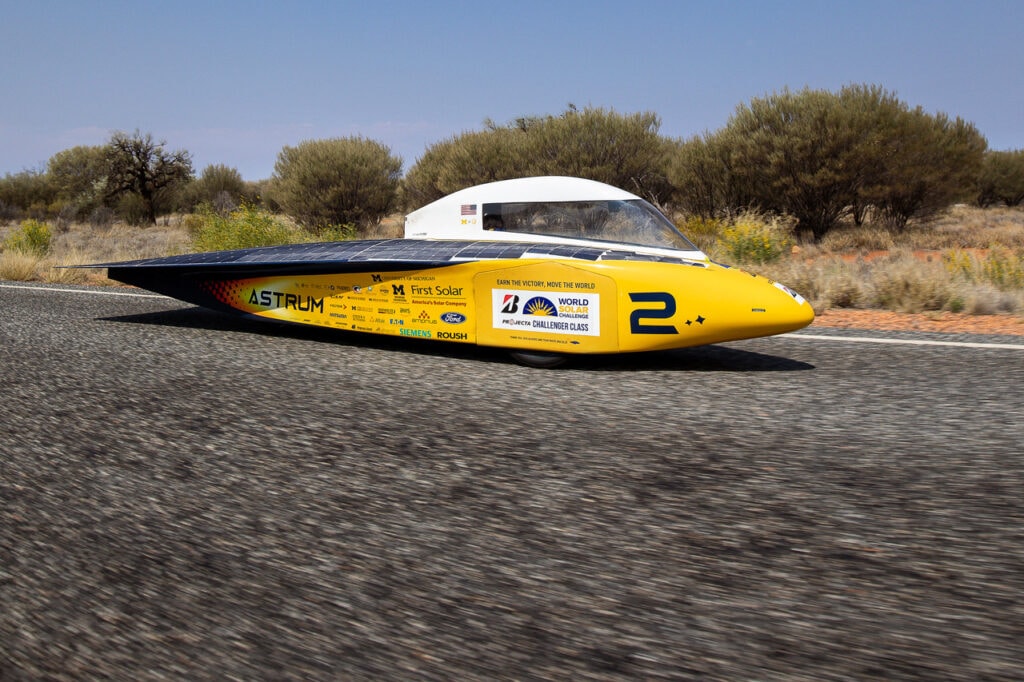
US solar car places fourth in global competition
After starting last, University of Michigan team overcame major setbacks in Bridgestone World Solar Challenge.

After starting last, University of Michigan team overcame major setbacks in Bridgestone World Solar Challenge.
Powered by the Australian sun, the University of Michigan Solar Car Team’s Astrum was the fourth challenger-class car to cross the finish line today after five days of racing in the 2023 Bridgestone World Solar Challenge.

The race spanned 1,800 miles from Darwin on the coast of Australia’s Northern Territory to Adelaide in the south.
“Placing fourth in the world is fantastic,” said Will Jones, the team’s race manager and a senior in mechanical engineering. “This team worked so hard and it’s so validating to finish where we did.”
The undergraduate team pulled off the impressive finish despite a rocky start at the back of the pack. Electrical issues shut Astrum down in the middle of the “hot lap” around the Hidden Valley Raceway track—a speed test that determines the racers’ order at the starting line. The car that finishes the hot lap in the shortest time starts the main event first. Because the U-M team couldn’t finish its lap, it would start behind 31 other cars.
It was a devastating setback, but the team patched up the issue in time to complete their remaining tests required to qualify for the race. They remained hopeful for a good run the following day.
“When Ethan, one of our drivers, went back out there to finish a brake test, I encouraged the team to cheer him on. We could not afford to mope around and just let stuff happen to us,” said Leo Intelisano, a sophomore majoring in computer engineering and one of the team’s microsystems engineers.
“We really came together after he passed the test. At that point, I think everyone realized that we were actually still in it.”

The Sonnenwagen Aachen team from Germany was first at the starting line Oct. 22. Their white, three-wheeled bullet car took off around 8 a.m., followed closely by Belgium’s Innoptus—who designed the finned Infinite—and the Netherlands’ Brunel, the seven-time world champions driving Nuna 12. U-M started the race around 40 minutes later.
“We effectively started with a penalty on top of the additional energy that we needed to overtake the cars that left Darwin ahead of us,” said Jones. “But, our strategists spent the entire year preparing for the competition by studying passing situations with mathematical models. So we were well equipped to adjust our speeds accordingly.”
Astrum took off at some of the fastest speeds in the competition—between 53 and 62 miles per hour—and passed car after car. When the team arrived at the control stop in Dunmara at the end of the first day, they had rocketed into sixth place and caught up to the fifth-place team, Tokai University, with whom they shared camp for the night.

The team kept their blistering pace in the following days. By the end of day three, Astrum was just under 50 miles behind the third-place team, Brunel.
Overtaking Brunel the following day would be a monumental task. Astrum’s battery was only 11% full, and the weather forecasts from one of the team’s sponsors, Meteoblue, suggested that they might need extra power to plow through strong winds on their way to the next stop in Glendambo. To make matters worse, the sun would likely be hiding behind clouds for most of the day.
But with their sponsor’s forecasts, they could come up with a plan. The first order of business would be to move slowly during the sunny part of the day to refuel. Then when the clouds came in, they would squeeze all the juice they could get out of the battery. In other words, put the pedal to the metal.
Michigan gave it their all, but the Dutch team managed to match Astrum’s pace and maintain the gap between them. Eventually, Brunel finished third behind Innoptus and Twente, another Dutch team.

The U-M team’s strong finish and resilience didn’t go unnoticed by fans stateside. Alumni followed the race closely, and their commentary makes one thing clear: The students have a lot to be proud of.
“The 2023 team started in 32nd place because they couldn’t finish the hot lap due to technical difficulties. But they didn’t quit,” wrote alum Andrew Warner on LinkedIn. He was on the U-M solar car team in 1993 and is now the president of Wartech Engineering. “Against so many odds, they looked the possibility of failure in the face and pushed onward. This is an experience that will likely shape how they respond to obstacles in the future, in life and in business.”
This year’s premier sponsor is First Solar. Platinum sponsors include Amprius, Ford Motor Co., Roush, Siemens and Michigan Engineering. View a full list of sponsors.

Astrum is the 17th car made by the Michigan Solar Car Team since its founding in 1989. The team has won the American Solar Challenge nine times, had podium finishes in the World Solar Challenge seven times, and won its first international championship in 2015 at the Abu Dhabi Solar Challenge.
With more than 120 students from schools and colleges across the university, it’s one of the largest student organizations on campus. For those students, the Bridgestone World Solar Challenge presents an exciting opportunity to develop their skills by pitting them against some of the world’s best solar car design teams.
Levi Hutmacher and Jeremy Little contributed to this piece on location in Australia.